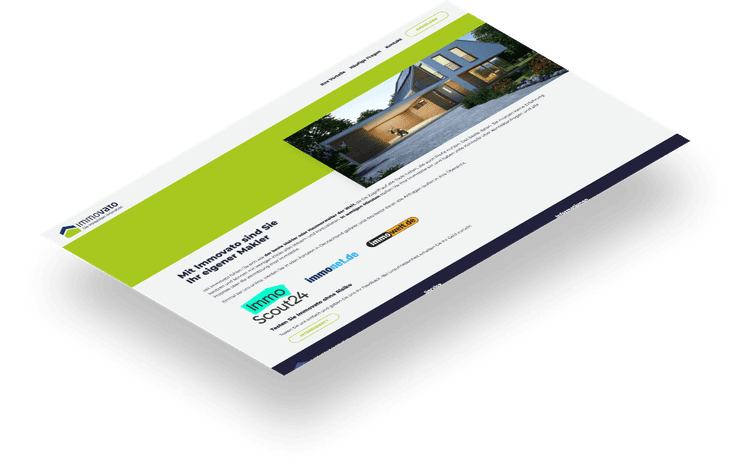Innovating the Real Estate Sector
Immovato
Tech used: React, TypeScript, Node.js, Express, Rest APIs



With Immovato I co-founded a SaaS startup, where we strived to innovate the real estate sector in Germany. Immovato was an online platform giving property sellers and landlords a set of tools, that is usually reserved for estate agencies. All of this was offered at a low monthly cost. While similar services are very familiar in the UK, the German market did not have any SaaS solutions for real estate offerings.
The first approach
Back in 2014, my co-founder, an established estate agent in Germany, and I sat together brainstorming how we would be able to innovate the real estate sector in Germany. As a UK resident myself, I was aware of innovative solutions in the UK, so we did a first market analysis for Germany and compared offerings in the UK and Spain to see what our product would look like. What we came up with was the following service for our MVP:
- Automatic listings on the most popular German real estate marketplaces (Scout24, Immonet and Immowelt)
- Custom API to offer commercial clients flexibility with implementations of third party applications
- Customer account management including subscription-based payment gateway
- Marketplace for property photographers, stagers and local estate agents to offer their services on a project basis
The next stage of research was focusing on the three German real estate marketplaces and how we would be able to communicate with them. One of the biggest struggles was, that some of them did not offer any API we would be able to hook into, so we would have to rely on webhooks, SFTP and email - not ideal to achieve our goal of a fully automated system. The marketplace that offered an API was using a very dated XML-based SOAP API (OpenImmo).
Branding
Since I had a background in design and development, I focused on the branding of our product next. While the iconic standalone logo was developed in one night, the actual brand name took much longer to nail down. The combination of “Immobilie” (German for “property”) and “Innovation” was finally chosen and Immovato was born.
The colour palette has been updated twice over the following years to keep up with current trends, but the overall design remained largely the same from 2014 to now.
Development
Together with two contractors and one part-time employee, we began the development work in November 2014. The tech stack we chose at the time was a Laravel (PHP) back-end with an AngularJS front-end. This was largely due to the experience of the engineers we chose to work with and also my own experience at the time, which was largely within the PHP world.
Unfortunately, we ran into several issues creating APIs to send our real estate listings to marketplaces, so the project became slower and slower in early 2015, which resulted in a financial bottleneck (at this point we had bootstrapped the app using our own funds) and the completion of the MVP was finally put on hold until we were able to raise funds to continue.
Through a small pre-seed round of around €50,000, we were able to continue around December 2015.
In the meantime, there has been a lot of movement in the technologies we were using. AngularJS had a new major version release, which was largely incompatible with our Angular 1 code, so we had to make an important decision:
Do we continue with AngularJS 1, do we upgrade to Angular 2 and hope that the framework does not change completely again with the next major version or switch to a different framework altogether?
At the time React has started to become the de facto choice for many startups and after some investigation and PoC development time we were convinced, that React would be an excellent choice for our product and despite it being very different to Angular, it would be a feasible effort to move our front-end codebase over.
But what about the back-end?
Since we have all worked in JavaScript much more and Node.js with the Express framework became much more popular, we decided to scrap the Laravel back-end while we’re at it and build on a MERN stack (MongoDB, Express, React, Node) instead. At the time it seemed sensible to make this decision now rather than continuing to build in PHP and JavaScript separately, later requiring different skillsets when we would eventually hire a larger engineering team.
Until the summer of 2016, we were working on the MVP but kept failing to integrate our product with the third-party services we required, due to the lack of APIs on their end, as described above. Additionally, we were running low on cash again and required the ready MVP to start raising a seed round.
Eventually, the decision was made to rely on manual input for the MVP stage. This meant a customer would sign up, book a package through our app and then my co-founder would manually add listings for marketplaces. This way we were able to have a soft launch of the product and serve a few customers to generate a small amount of capital to continue with the development process.
Unfortunately, we were not able to raise further capital in a seed round at the time and Immovato was put on hold.
What are my key learnings?
Running a business and building a SaaS solution with limited resources is hard. However, I have gained valuable experience managing software engineers and also managing the expectations of stakeholders. The leadership experience I have gained with Immovato has been valuable in my further career in senior and lead engineering roles I have since worked in.
The experience of moving a codebase from Angular to React has also taught me a lot about best practices and the value of high-quality code. Without this experience, I would not have learned React as early as I did, which has given me a significant benefit when I first started working as a contractor.